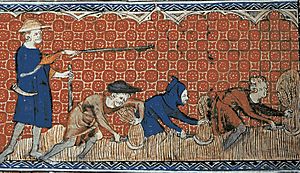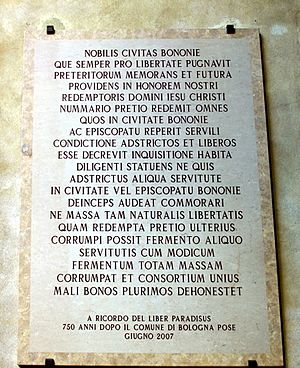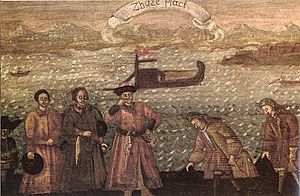Serfdom facts for kids
Serfdom was a system where people called serfs were forced to work for a powerful landowner, known as a lord. This happened a lot in medieval Europe. Serfs were peasant farmers who worked on the lord's land without getting paid in money. In return, they were allowed to live and farm on the lord's estate, called a manor. The lord also offered them protection.
Serfs had more rights than slaves. For example, serfs could own some property. However, they were not truly free. They could not move, marry, or leave the manor without the lord's permission. In most places, serfs were legally tied to the land. If the land was sold, the serfs living on it were sold along with it. Serfs mainly worked in the lord’s fields. They also did other jobs related to agriculture, like forestry and moving goods by land or river. Some serfs also worked as craftsmen or in small factories.
Serfdom grew out of agricultural slavery in the Roman Empire. It became common across Europe around the 10th century. During the Middle Ages, most people in Europe lived under serfdom. This system lasted until the 1600s in England and until 1789 in France. In most other European countries, serfdom continued until the early 19th century. In the Russian Empire, serfdom became very common in the 18th century. Alexander II of Russia finally ended it in 1861.
Contents
What was the Serfdom System?
During the Middle Ages in Europe, kings and queens, the Catholic Church, and the nobility (rich, powerful families) owned almost all the land. Serfs did not own land themselves. Instead, they did hard work for these landowners. In exchange, they got a place to live and work. Most serfs were workers in the fields. But some were skilled craftsmen, like the village blacksmith, the miller (who ground grain), or the innkeeper.
The Serf's Feudal Agreement
Serfs had a special agreement, much like a baron or a knight. This was called a feudal contract. A serf's feudal contract said they would live and work on a piece of land owned by their lord. A serf was allowed to have their own home, fields, crops, and animals on the lord’s land. In return for their work, the serf would get protection from the lord.
During feudal times, people had different roles. They said a serf "worked for all," a knight or baron "fought for all," and clergy (church leaders) "prayed for all." Serfs were in a lower social class than knights and barons. However, they were better off than slaves. A lord could not sell his serfs like Romans sold slaves. Serfs were legally tied to the land they worked on. If their lord sold his land, the serfs were sold along with the land. Serfs could not sell the land they lived on. They also could not leave the manor without their lord’s permission. Often, they needed the lord’s permission before they could marry someone who was not also a serf for that lord.
How Someone Became a Serf
A free man usually became a serf if he owed a large debt. He would make an agreement with the lord of the land. The lord would keep him safe, give him money to pay his debt, and give him land to work on. In return, the man would work for the lord. All his children would also become serfs.
What Serfs Had to Do
Serfs had to pay taxes to their lord. The lord decided how much each serf had to pay. This was based on the size of the land the serf lived on. Usually, serfs had to pay about one-third of their land’s value in taxes. When the lord was fighting a war, serfs also had to pay extra wartime taxes.
Money was not very common during the Middle Ages. Serfs usually paid their lord by giving food and working without pay. Serfs often spent five or six days a week working for their lord. On these days, the lord would give his serfs better food. However, serfs had to do the lord’s work before they could do their own work. For example, when the lord’s crops needed to be harvested, the serf’s own crops also needed harvesting. Still, the serf could not harvest his own food until he had finished his required work for the lord.
At different times of the year, serfs did different tasks. A serf might plow his lord's fields, harvest crops, dig ditches, or repair fences. The rest of his time, he could take care of his own fields, crops, and animals. There were even strange tests to decide if something was good enough for taxes. For example, a chicken had to be able to jump over a fence. This showed that the chicken was young and healthy.
Lords also made serfs pay fines for certain actions. For example, a serf would have to pay a fine:
- If he inherited money or property.
- If he became a priest or monk.
- If his children moved to a city instead of staying on the lord’s manor as a serf.
- If he used his own mill to grind the grain he grew.
When a serf died, his children could only stay on the land if they gave the lord their best animal. Serfs also had to pay to use the lord’s grain mill. Many serfs thought this was unfair. Millers charged a fee called multure, usually 1/24 of the total grain milled. Serfs often believed the millers were not honest. Many serfs also had to use their lord’s ovens to bake their daily bread. They had to pay to use these ovens. They also had to pay to use the lord’s carts to carry their produce.
Good Things About Serfdom
Serfs did have some freedoms. They could get and keep property and money. Some serfs had more money and property than their free neighbors. Sometimes, serfs could even buy their freedom. The lord could not make serfs leave his land unless he had very good reasons. The lord was supposed to protect them from criminals or other lords. He was also supposed to give them help during famines (when there was not enough food).
Serfs could grow what they wanted on their own lands. Sometimes they had to pay their taxes in wheat, which is hard to grow. They could take the wheat they did not give for taxes to the market to sell. Most serfs were subsistence farmers. This means they ate what they grew. Their heirs (children) usually got an inheritance of their property.
How Serfdom Changed
The rules for serfdom were different at different times and in different places. In some areas, serfdom changed into different types of taxation. For example, in the 13th-century Polish-Lithuanian Commonwealth, serfs had to work two to three days a week for their landlords. By the 17th century, they had to work four days per week.
Sometimes, serfs had to be soldiers during war. They could earn their freedom or even become nobles as a reward for being brave in war. Serfs could also gain their freedom in other ways. Sometimes they could buy their freedom. Kind or generous owners could free a serf. This was called manumission. Some serfs were able to run away to other towns or to new lands where people would not ask about their past. Laws were different in each country. In England, a serf became free if he reached a chartered town and avoided being caught for a year and a day.
When Serfs Became Free
When people started to use money more, and barter (trading goods) became less important, serfdom began to change. Lords could now make money by renting their land. This was more profitable than getting unpaid work from serfs. Many lords "freed" their serfs when their work became less valuable than money.
Even after being freed, the serfs' lives did not change completely. They still had to farm their land, take care of their families, and pay their taxes. However, they could no longer be forced off their lands if they did not pay rent. Also, their lord could not decide to use their fields for a different purpose.
History of Serfdom
Early Forms of Serfdom
The helots in the ancient Greek city-state of Sparta worked like serfs. So did peasants working on government lands in ancient Rome. However, these workers were not called “serfs.” Instead, they were called coloni, meaning "tenant farmers.” When Germanic tribes took over the Roman Empire, they took lands from the wealthy Romans. These tribes became the new lords, keeping a similar economic system of serfdom.
Serfdom in Western Europe
Medieval serfdom in Western Europe started after the Carolingian Empire broke apart around the 10th century. This empire had ruled most of western Europe for over 200 years. After it broke up, Western Europe did not have strong central governments for a long time. During this period, feudal lords worked to make serfdom the common way for people to live. Under serfdom, rich landowners could force others to work for them and feed them. Serfs did most of the farm work in medieval Western Europe. Slavery did exist then, but it was not as common. Slaves were usually only used to take care of people’s houses. Some parts of Europe, like much of Scandinavia, never used serfdom or other feudal systems.
Serfdom in Eastern Europe
Serfdom came to Eastern European countries later than Western Europe. It began in Russia around the 12th century, but it did not become common until several hundred years later. By the 17th century, serfdom was the most common relationship between Russian peasants and the nobility. It was most common in the central and southern areas of the Tsardom of Russia, and later the Russian Empire.
Serfdom in Ukraine, other Cossack lands, the Urals, and Siberia was rare until the rule of Catherine the Great (1762–1796). At that time, it spread to Ukraine. Noblemen began sending their serfs into Cossack lands to use their many natural resources. Russian serfdom was different from other Eastern European countries. It was not changed by German law or by people coming from Germany. In Russia, serfdom and manor systems were enforced by the crown (the Tsar), not by the nobility.
The End of Serfdom
Serfdom Ends in Western Europe
By the 13th and 14th centuries, serfdom was becoming less common in Western Europe. The manor system became weaker as powerful monarchs took control, towns grew, and the economy got better. At the same time, there were more protests by serfs and peasants. An example is Wat Tyler’s Rebellion in England in 1381. These protests pressured the nobility and church leaders to change the system. New ways of renting land gave people more freedom. By the 15th and 16th centuries, serfdom was ending in Western Europe. As the economy continued to change, serfdom became less profitable than renting land for money. Other reasons for the end of serfdom included changes in the population and new laws about what lords could make their tenants do.
The Industrial Revolution also helped to end serfdom. Landowners began to put their money into factories, because they made more money this way than from having serfs. This led to urbanization, where towns grew bigger. As towns grew, farmers wanted to move off of manors. They could make more money working in town than they could by working in a lord’s fields. In England, serfdom ended around 1600. After the Renaissance, serfdom was not common in Western Europe. However, as serfdom was ending, chattel slavery (where people were owned like property) was beginning in the English-speaking parts of the Western Hemisphere.
Serfdom Ends in Eastern Europe
Serfdom existed in Russia until February 19, 1861. In Russian Baltic provinces, it ended earlier, at the beginning of the 19th century.
Dates Serfdom Ended in Europe
- Savoy: December 19, 1771
- Baden: July 23, 1783
- Denmark: June 20, 1788
- France: November 3, 1789
- Switzerland: May 4, 1798
- Schleswig-Holstein: December 19, 1804
- Grand Duchy of Warsaw (Poland): July 22, 1807
- Prussia: October 9, 1807 (fully ended 1811-1823)
- Mecklenberg: October 1807 (fully ended 1820)
- Bavaria: August 31, 1808
- Nassau: September 1, 1812
- Estonia (Russian Empire): March 23, 1816
- Courland (Russian Empire): August 25, 1817
- Württemberg: November 18, 1817
- Livonia (Russian Empire): March 26, 1819
- Hannover: 1831
- Saxony: March 17, 1832
- Austria: September 7, 1848
- Hungary: March 2, 1853
- Bulgaria: 1858 (when feudalism ended in the Ottoman Empire; practically 1880)
- Russia: February 19, 1861
- Danubian Principalities (Romania): August 14, 1864
- Bosnia and Herzegovina: 1918
Modern Ideas of Serfdom
Some people say that planned economies, especially those like the Soviet-style Communist system, were a form of government-owned serfdom. For example, the Soviet collective farm system. Friedrich Hayek wrote about this idea in his book The Road to Serfdom.
Mikhail Gorbachev grew up in a kolkhoz, which was supposed to be a collective farm. There were also sovkhoz, which were state-owned farms. The government used a system of internal passports and household registration (like China's hukou system) to make people stay on their farms. They had to plant crops according to instructions from the central government. The state then bought their farm products at low prices and put a lot of money into industrialization. Gorbachev said this was very much like being a serf. This kind of system lasted in Russia until 1974. In that year, a government rule gave peasants identification documents and the right to move freely within the country for the first time in Russian history. It is possible that a similar system still exists in rural China.
Related pages
- Indentured servant
- Farm
- Fiefdom
- Yeoman
- Villein
Images for kids
See also
 In Spanish: Servidumbre para niños
In Spanish: Servidumbre para niños






